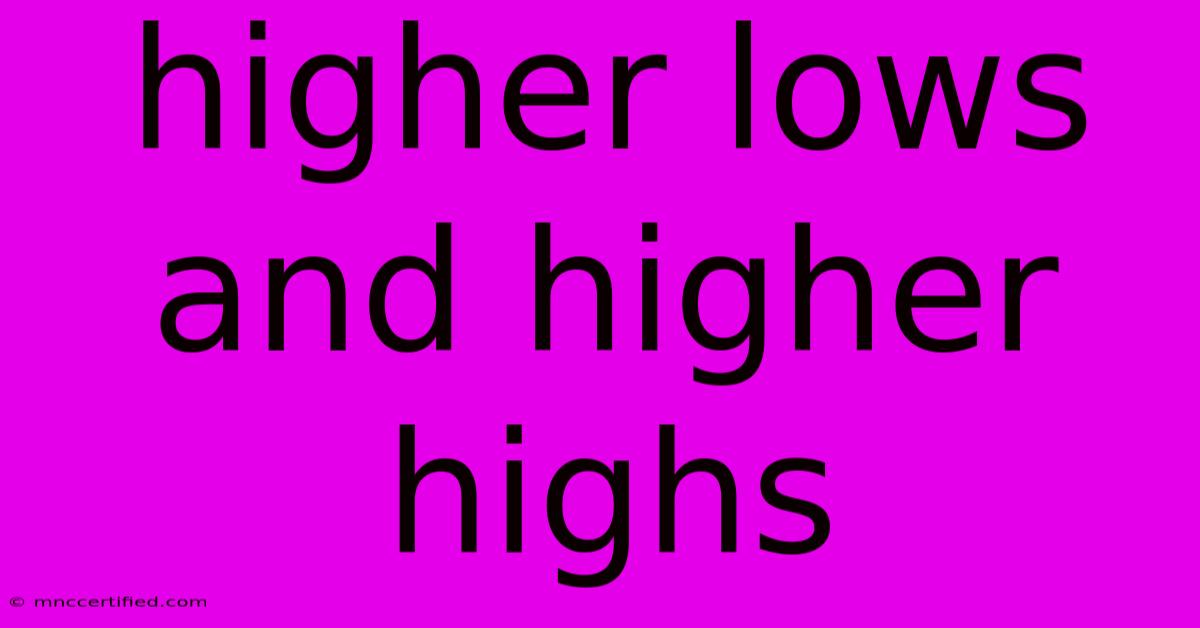Higher Lows And Higher Highs

Table of Contents
Higher Lows and Higher Highs: Understanding This Bullish Trend
Higher lows and higher highs, often referred to as a rising trend or uptrend, are a fundamental concept in technical analysis that signals bullish momentum in a market. Understanding how to identify and interpret these patterns can significantly improve your trading and investing strategies. This article will delve into the meaning, identification, and implications of higher lows and higher highs.
What are Higher Lows and Higher Highs?
In simple terms, higher lows refer to successive troughs in price that progressively increase, while higher highs refer to successive peaks that progressively increase as well. This creates a pattern where each subsequent low is higher than the previous one, and each subsequent high is higher than the previous one. This upward sloping pattern visually shows a strengthening bullish trend.
Imagine a graph charting the price of a stock over time. A series of higher lows and higher highs would appear as an upward-sloping line, with each valley (low) and each peak (high) progressively higher than the previous ones.
Identifying Higher Lows and Higher Highs
Identifying these patterns requires careful examination of a price chart. While subjective interpretation plays a role, several key aspects can help solidify the identification:
- Timeframe: The timeframe chosen significantly impacts the identification. What appears as higher lows and higher highs on a daily chart might not be evident on an hourly chart, and vice-versa. Experiment with different timeframes to find the most meaningful patterns.
- Support and Resistance: Higher lows often represent the rising support level, while higher highs represent the rising resistance level. Observe how price interacts with these levels.
- Trendlines: Drawing trendlines connecting the successive lows and highs can visually confirm the pattern. A consistently upward sloping trendline is a strong indicator.
- Volume: Confirming the trend with increasing volume during price rises adds further weight to the bullish signal. Rising volume indicates increasing buying pressure.
Example: Spotting the Pattern
Let's say a stock's price dips to $50 (low 1), then rallies to $60 (high 1), subsequently dips to $55 (low 2), and then rallies to $65 (high 2). Here, low 2 ($55) is higher than low 1 ($50), and high 2 ($65) is higher than high 1 ($60). This classic example shows higher lows and higher highs, indicating a bullish trend.
Implications of Higher Lows and Higher Highs
The appearance of higher lows and higher highs suggests a positive trend with increasing buying pressure. This pattern generally indicates:
- Bullish Momentum: The market is trending upwards, suggesting potential for further price increases.
- Increased Investor Confidence: Rising prices often attract more buyers, further fueling the upward trend.
- Potential for Long-Term Growth: This pattern is often seen in stocks experiencing significant growth or in a market experiencing a bull run.
However, it's crucial to remember that no trend lasts forever. Higher lows and higher highs can eventually reverse, so always employ risk management strategies and consider other indicators before making any investment decisions.
Higher Lows and Higher Highs vs. Other Patterns
It’s important to differentiate higher lows and higher highs from other patterns. While it’s a clear indication of an uptrend, it shouldn't be confused with:
- Consolidation: Periods of sideways trading where price fluctuates within a range, lacking the consistent upward movement of higher highs and higher lows.
- Head and Shoulders: A bearish reversal pattern indicating a potential trend change.
- Double Tops/Bottoms: Patterns that could signal a temporary pause or change in trend direction.
Conclusion: Utilizing Higher Lows and Higher Highs
Higher lows and higher highs are a powerful indicator of bullish momentum in the market. By carefully analyzing price charts and understanding the underlying principles, investors and traders can utilize this pattern to make more informed decisions. Remember to always combine this analysis with other technical indicators and fundamental analysis for a more comprehensive and robust approach to trading and investing. Don’t rely solely on this pattern; consider the overall market context and your own risk tolerance before committing capital.

Thank you for visiting our website wich cover about Higher Lows And Higher Highs. We hope the information provided has been useful to you. Feel free to contact us if you have any questions or need further assistance. See you next time and dont miss to bookmark.
Featured Posts
-
Gold 20 Cent Euro Coin Value
Nov 30, 2024
-
Harry Potter Stars Tax Woes
Nov 30, 2024
-
Bond Arms Cross Draw Holster
Nov 30, 2024
-
Best Black Friday 2024 Ps 5 Deals
Nov 30, 2024
-
Show Me Your Mumu Size Chart
Nov 30, 2024